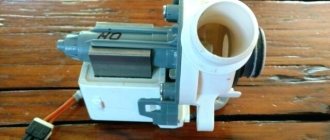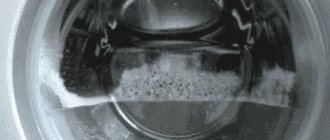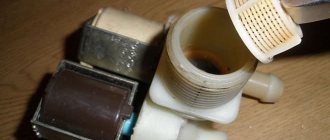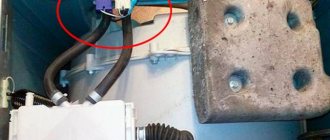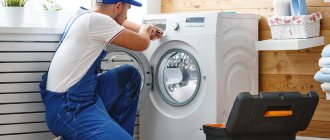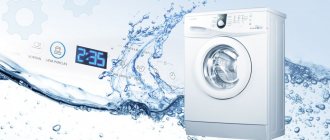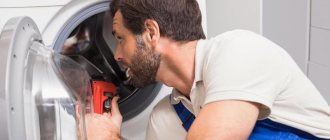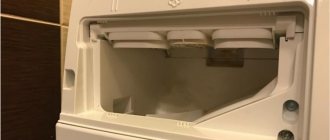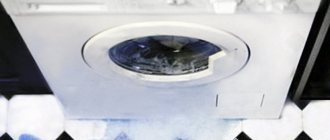Modern washing machines are designed in such a way that we select a program for a particular type of fabric, and the machine itself determines how much water it will draw. Sometimes situations happen when the machine makes a mistake with the amount of water required. And then either the laundry is not wet enough, and as a result we get poor quality washing, or, conversely, there is too much water, which can lead to flooding of important parts inside the machine itself.
If your washing machine stops working, contact FixWasher. The technician will promptly repair equipment at home in Moscow and the Moscow region. Call to leave a request or use the button on the website. Our employees will answer your call regardless of the day of the week. The craftsmen also work seven days a week.
Why does the washing machine not add water or overflow?
A special water level control system or pressure system controls the amount of water entering the machine. The main element of this system is the water level sensor. In another way it is called a pressure switch. It works on the principle of a pneumatic relay. Those. Water entering the tank increases the air pressure in it. This is transmitted to the pressure switch, which sends a signal to the control unit. This signal stops water from entering the machine.
Sometimes situations arise when the relay incorrectly determines the level. And either it gives the command to stop supplying water too early, or it does not turn off on time. Most often, such situations arise if:
- Pressure sensors are faulty.
- The machine is incorrectly connected to the water supply and sewerage system.
- The intake mechanism is clogged or faulty.
- The control unit is faulty.
Let's analyze each situation separately.
Reasons why the unit does not take in water
There may be several reasons for this malfunction, the most obvious among them:
- Lack of water in the water supply is the most common reason. It's easy to check - you just need to open any tap. Maybe the water pressure is insufficient - this can also be seen visually by opening the tap in the washbasin. It also happens that the valve through which water flows into the inlet hose is accidentally closed.
- Clogged inlet line. Most likely, the inlet strainer is clogged due to poor quality tap water. It is less likely that the inlet hose is clogged, but such cases also happen.
Washing machine inlet hose
The listed reasons are easily detected and eliminated independently. The inlet hose is disconnected from the SMA, then the mesh filter is carefully removed from the inlet hole in the machine. If there is a blockage, the mesh is cleaned and washed under a strong stream of water.
The mesh filter is removed with pliers
The inlet hose should also be inspected for damage and rinsed under a strong stream of water.
In addition to the simplest reasons for the lack of water supply to the unit, there are others.
Hatch door malfunctions
The hatch of each washing machine has a locking device (hereinafter also referred to as UBL, lock), which locks the door as soon as the washing program starts. This occurs in order to prevent the door from opening and liquid leaking from the drum. The hatch is closed throughout the entire duration of the program.
Washing machine hatch door
When the door closes, you should hear a click as the door tongue engages the latch inside the frame. If this does not happen, it means the door is not closed completely. In this case, the signal to close the hatch is not sent to the control unit, and water does not enter the drum of the washing machine. There may be several reasons why the door does not slam shut:
- the hatch hinges are loose, so the tongue cannot get into the latch;
- the door tongue is damaged or dislodged;
- rubber gasket is deformed;
- The plastic guide is damaged.
If the door latches normally, but a second click is not heard, indicating blocking, it means that the UBL has failed or the control unit board is faulty.
The most common mechanical defect is misalignment of door hinges as a result of prolonged exposure to vibration. The “fix” is simple - you need to tighten the hinge fasteners with a screwdriver or replace them with new ones.
The most common electrical fault is a lock failure. What to do in this case? You can replace the UBL yourself; the lock is relatively inexpensive. To do this you need to do the following:
- Open the hatch door.
- Remove the elastic cuff sealing the drum. To do this, pry it up with a screwdriver and remove the clamp that holds it.
- Unscrew the screws holding the lock.
- We take out the UBL through the hole between the cuff and the body.
- Disconnect the connector and connect it to the new device.
- We install the new device in place.
Sequence of actions when replacing UBL
The whole job takes just a few minutes. After this, you can turn on the SMA and make sure that it pumps water into the tank.
A visual demonstration of replacing the locking device in a Beko washing machine in the following video:
Inlet valve failure
This defect is one of the main reasons why the washing machine does not fill with water. This part controls the supply of water to the tank. The operation of the valve is regulated by an electronic control unit (hereinafter also referred to as the ECU), which sends signals about the opening and closing of the valve.
Washing machine inlet valve
The main elements of the part are electromagnetic coils that unlock and lock the valves for the flow of water. In most modern models, the valves have two control coils that distribute the flow of water to sections that are filled with detergent.
You can diagnose and replace the part yourself. To do this, turn off the power to the washing machine, then open the top cover, disconnect all the pipes from the valve, unscrew the fasteners and bend the latches, if any. Remove the valve from its seat.
Removing the fill valve from the machine body
It is easy to check the integrity of the coils - when checking with a multimeter, their resistance should be in the range of 2–4 kOhm. In the event of a break or short circuit, the part must be replaced. A new valve is relatively inexpensive.
Pressostat defect
This part is a pressure sensor that determines the water level in the tank. The pressure switch can be found on one of the panels if you remove the top cover of the SMA housing. As a rule, the part has a round shape and a pipe from the tank is connected to it.
Pressostat in the washing machine
The pipe connected to the sensor transmits the air pressure in the tank to its membrane. As water fills the tank, pressure increases as air is forced out. As soon as the pressure reaches the desired level, the pressure switch gives a signal to the electronic control unit and it stops the water supply.
To check and replace the part, you need to disconnect the pipe by loosening or removing the clamp, then check it for blockages, kinks and damage. If everything is in order with the pipe, connect a piece of another hose of the same diameter to the sensor and blow into it. When a working pressure switch is activated, characteristic clicks should be heard. If this does not happen, you will have to replace the part by first removing the fasteners.
Control unit malfunction
If the SM does not take in water and does not wash, the fault may be with the ECU. For example, its electronic board may not give a signal to turn on the inlet valve. It happens that the ECU gets stuck. Then you need to remove the plug from the socket and wait about half an hour. If turning it on again does not correct the situation, you will have to call a technician to diagnose the problem.
ECU - a device that controls the operation of the washing machine
In most cases, malfunctions associated with the water supply to the SMA can be eliminated independently. According to statistics, a simple lack of water and blockages are most often the cause of this phenomenon.
Incorrect connection to sewer and water supply
Often, users want to save money on connecting a new washing machine and install it themselves, not always following clear installation rules. So, for example, you need to know that the drain pipe must be installed in the sewer at a level not lower than 50-60 cm. If it is located below the water level in the tank, it will spontaneously flow out of the machine. The machine will constantly retrieve it. The powder will go down the drain, and as a result, the quality of the wash will suffer.
If you need to make sure that water flows out of the tank uncontrollably, you need to press pause while draining. If you hear that water continues to drain, it means that the machine is not connected correctly to the sewer system. In this case, you need to call a specialist to connect it correctly.
How to wash in an automatic washing machine?
We suggest following general recommendations when washing:
- Wash light-colored cotton and linen clothes at 95°. ...
- Before washing colored cotton items, select a temperature of 60 degrees. ...
- Washing clothes made of synthetics – no more than 50°. ...
- Wool and silk require a 40-degree temperature and a spin speed of no more than 600 rpm.
Interesting materials:
How to take a long screenshot on Xiaomi? How to take a long screenshot of the screen? How to take a long Huawei screenshot? How to take a long screenshot on iPhone? How to take a long screenshot on Huawei p20 Pro? How to take a long screenshot on Huawei p30 Pro? How to take a long screenshot on Huawei p30? How to take a long screenshot on iPhone? How to take a long screenshot on Huawei? How to take a long screenshot on PC?
Malfunction of the pressure switch - water level sensor
The pressure switch controls the water intake level. When it reaches a certain level, a command is sent from the sensor to the control unit, and filling with water stops. If the pressure switch fails, the water intake does not stop at the right time.
Upon inspection, the following faults can be detected:
- The water level sensor tube has become clogged, torn or fallen off.
- A large amount of scale and mucus has accumulated in the sensor chamber.
- The sensor contacts have oxidized or come apart.
- The relay itself is faulty.
- Intake valve malfunction
Our professional technician can find the breakdown and repair or replace the part.
Water supply valve is closed
The situation seems banal, but it happens all the time. Perhaps work was being done on the water supply, or the valve was closed by mistake. It happens that they close everything off to be on the safe side, and then forget to open it.
The machine hums, but the water does not flow. The solution in this case is obvious.
Inlet hose
Overflow of water during washing - possible reasons
There are several reasons why a washing machine takes up a lot of water.
The first lies in the incorrect connection of the drain hose. The machine collects the correct amount of liquid, and it spontaneously drains into the sewer. Afterwards, the mechanism again adds water to the required amount.
Another reason occurs when the control unit fails. There was too much water, the machine stopped the washing program, drained the water, and an error message appeared on the display. In such a situation, you can try to restart the machine. Those. completely disconnect it from the power supply. And after a few minutes, turn it on again and select the desired program.
If the machine again begins to take in an excessive amount of water, then the pressure switch has probably failed. And professional intervention is required.
By the way, it should be noted that overflowing water in modern washing machines does not lead to flooding of the electronic elements and components of the equipment itself, much less to flooding of neighbors. Such situations were possible in old models of automatic machines, mainly domestically assembled. Modern models are equipped with overflow protection, which turns on when there is an unusual increase in water in the tank. The machine starts draining, and an error message appears on the display.
The washing machine draws water slowly - reasons that can be eliminated yourself
There are a number of situations when the washing machine fills the tank very slowly due to technical or mechanical obstacles to the movement of water. Here are the main ones.
Low water pressure
When the water pressure is below normal, the tank does not fill in the allotted time, and the washing machine drains the minimum that it managed to collect, stops the program and reports with an error on the display that “there is no water.”
You cannot correct the situation on your own; call the management service and ask when the water supply will return to normal.
Shut-off valve is not fully open
According to the installation rules, the SMA must have a separate tap at the connection to the water supply that shuts off the water. This is necessary for prevention, repair and general safety. When you leave home for a long time, the tap should be turned off. But when opening the valve, you may not turn the handle, which means that water will flow into the hose worse than usual.
The faucet may also get stuck without opening all the way. Most often, old taps become stuck. Small grains of sand after repair work on the pipeline slip even through the coarse filter and block the rotation of the ball valve mechanism. This faucet must be replaced with a new one.
The inlet hose is kinked or pinched
In order for the machine to draw water normally, the inlet hose must be free. Look at the condition it's in. If there is a clamp or bend, straighten the hose and check the speed of water intake. Has she become normal? So you have found the reason.
Intake valve strainer clogged
There is a strainer between the inlet hose and the inlet valve. It protects the SMA from small particles found in tap water. Over time, the filter becomes clogged, even if the water is clean. Calcium deposits appear on the mesh, and its throughput decreases.
The filter needs to be cleaned regularly, but is usually forgotten about. If the water is pouring in too slowly, but everything is normal with the hose, tap and pressure, then it’s time to do some maintenance. The filter can be cleaned mechanically, with a thin needle, or soaked in citric acid.
The procedure is as follows:
- Unplug the machine.
- Move away from the wall to get to the hose.
- Close the water valve.
- Place a bucket or bowl to collect water.
- Unscrew the inlet hose and lower it into the container.
- Pull the strainer out of the hole.
- Clean it.
- Put it in place.
- Screw on the hose.
- Open the valve.
- Connect the machine.
- Start the test by setting it to rinse mode.
Intake valve malfunction
When a command is received from the control unit, the inlet valve opens. And water begins to flow into the machine. If there is enough of it, the pressure switch is activated. From it a signal goes to the control unit, which opens the circuit with the valve. And it closes. The water stops filling.
The intake valve usually fails due to normal wear and tear. Particles of scale, rust, and detergent residues are deposited on its walls. This plaque either jams the membrane in the closed position or prevents it from closing and opening completely. In any case, the water supply suffers. There is either too little of it or it is constantly being replenished. You cannot operate equipment with a faulty inlet valve. A part needs to be replaced.
DIY troubleshooting
It should be remembered that all actions related to repairing a washing machine must be carried out with the machine disconnected from the power source and the water supply tap turned off.
If water does not fill into the machine and you hear a buzzing sound, first of all you need to:
- See if the water supply tap is open.
- If this tap is open, turn it off and disconnect the water supply hose by lowering it into a container, since as a result of such manipulations liquid will flow out of it.
- Inspect the hose for kinks and straighten it if necessary.
- Check the inlet hose filter - it may be clogged. To do this, you need to unscrew the hose and find the mesh filter. The filter has a special indentation, which you need to grab with pliers and pull out the mesh. You can clean the filter with a needle under high water pressure, and then insert the valve into its original place.
- Check the hard cleaning filter, it is also a mesh. If a meter is installed, then, as a rule, a filter is installed after the tap. In order to get to this filter, you will need two keys: one to fix the connection to the tap, and the other to unscrew the bolt. Then place the container and open the tap. Thanks to the flow, the filter will be cleaned, and it can be screwed on, also secured with a key at the junction with the tap.
Quite common reasons, as already mentioned, are valve failure and heating element malfunction. You should study the instructions for repairing these parts.
How to wash a feather pillow at home
Valve replacement
- Disconnect the machine from the power supply and turn off the water. We disconnect the hoses from the back of the machine (where the valves are located), preparing in advance a container for draining the water.
- We unscrew all the fasteners on the top cover of the machine.
- We remember the location of the wires on the coil and disconnect them.
- Using pliers, remove the fastenings of all four hoses, having previously remembered their location.
- We unscrew the screw for securing the valve (located at the back) and remove the inlet valve.
- We install the new valve, securing it with a screw in the bracket using a screwdriver.
- We return the hoses to their original place and secure them with clamps. We connect all the coil wires in series.
- We return the cover of the machine to its original place and secure it with screws. We connect the hoses.
- We check the serviceability of the washing machine by first connecting the water and turning on the machine.
Heating element malfunction
Open the back cover of the machine, remove the wires using pliers and pull out the connectors. Using a socket wrench, unscrew the nut holding the heating element, pull out the heating element together with the rubber seal and insert a new one according to the grooves for better fit of the part.
We lubricate the rubber seal of the new heating element with dishwashing liquid for easier insertion and install it in the right place. We insert the temperature sensor, screw in the retaining nut, and connect the wires. Close and secure the back wall of the machine. The renovation is complete.
If the problem is detected and corrected in a timely manner, breakdowns beyond repair can be avoided, so action should be taken at the first sign of malfunction.
The washing machine does not add water when washing - reasons
If the washing machine does not draw enough water, then this is also bad. The washing powder is not completely removed from the ditch, the clothes are not wet enough, and the quality of the wash suffers. And, in addition, with a small amount of water, the heating element works with high voltage, which can cause its breakdown. This situation can arise as a result of several reasons:
- The water level sensor is faulty.
- The machine is not connected to the sewer system correctly.
- The pressure in the public sewerage system has increased, which activates self-draining of water.
Weak water supply
If water fills into the washing machine very slowly, there are many reasons for this:
- Insufficient water pressure . It is worth checking the pressure and the water supply valve; it may not be fully open. If both the pressure and the tap are fine, perhaps the reason lies in other failures.
- in the inlet valve is clogged The filter is located in front of the inlet valve and looks like a fine mesh. It is necessary to retain large particles. As a result of using the washing machine, the filter may become clogged, and then the liquid does not flow well into the machine. To eliminate this type of breakdown, it is worth cleaning the filter. If this is the cause of the breakdown, then you need to clean the filter immediately, since otherwise it will become completely clogged and water will not flow into the machine at all.
- The additional filter is clogged . It is usually installed in front of the filling hose.
How to quickly dry washed jeans
The water drains itself
If the machine initially pours the required amount of water, but during the washing process it leaves for some reason, then the unit constantly replenishes the lost water. As a result, the heating element is constantly turned on, because he needs to heat the water to the required temperature. The washing process increases.
Why can water drain spontaneously? This may occur due to increased pressure in the sewer or improper installation of the machine. In this case, you need to install a special anti-drain valve on the drain hose. It will prevent water from draining from the tank on its own.
How to determine that the machine cannot fill with water
When the laundry in the drum is dry, the SM hums and does not spin the drum, the breakdown is clearly visible. But there are situations when there is water in the drum, but the wash does not start and it is not clear what happened. It may also be that the water flows too slowly and the machine identifies this as a breakdown. In this case, a fault code appears on the display. SMAs without a display indicate a breakdown by flashing indicators.
Electrolux machine with code E10 reports that water is not entering the tank
For example, if the Indesit washing machine does not draw water, the combination H20 appears on its display. The same code is displayed in SM Ariston and Hotpoint Ariston. Electrolux and Zanussi units display message E10 or E11. The following information appears on the displays of washing machines of other brands:
- Samsung – E1;
- LG – PE or IE;
- Bosch – F01 or Aquastop;
- Whirlpool – FH or F1;
- Candy – E02;
- Asko – E01 or Water inlet fault.
If there is no display, the malfunction can be recognized by a combination of flashing indicators (each brand of SM has its own, you can find it in the instructions for use).
Diagnostics of a malfunction of the pressure switch water level sensor
Very often, the cause of a lack or excess of water is a malfunction of the water level sensor. It is inexpensive, but the main difficulty in independently diagnosing a malfunction of the pressure switch is the need to disassemble the washing machine.
Sequence of actions when diagnosing a malfunction of the pressure switch:
- Let's disassemble the machine.
- We unscrew the sensor itself and disconnect it from the tube.
- We blow into the pressure switch hole. If the part is working properly, clicks will be heard. Their number corresponds to the number of programs.
- We examine the tube. If it is damaged, it needs to be replaced. If dirt and deposits are visible on its walls and in the lumen, it must be cleaned and rinsed under running water.
- We're putting the car back together.
If your Samsung, LG, Ardo, Zanussi, Bosch, Electrolux, Beko, Indesit, Candy, or any other washing machine has stopped working, contact FixWosher. Our technician will quickly and efficiently repair your equipment. The cost of repairing a washing machine will depend on the damage identified and the complexity of the repair. You can leave a request on the website or by phone; the company is open from 7:00 to 23:00.
Possible causes and solutions
| Probable Cause | Photo | How to check | How to fix |
| No flow or low pressure from the water supply | When you open the taps of the water supply system, water does not flow or flows weakly | Turn off the machine and wait for the problems in the plumbing system to be resolved | |
| Clogged inlet hose or inlet strainer | Disconnect the supply hose and filter, inspect them and blow them out | Clean the hose and filter from debris and rinse under running water. | |
| The side door is not closed tightly, the lock does not work | Check the tightness of the door, the condition of the locking mechanism and the fastening of the door hinges | Press the door firmly until the lock clicks. If necessary, clean the latching mechanism and tighten the hinges | |
| Damage to connecting wires or their insulation, oxidation of contacts | Inspect and test the internal electrical wiring with a tester for open circuits and short circuits. | Restore the integrity of electrical wires and their insulation, clean contacts | |
| The inlet (fill) valve does not work | Check the operation of the valve when 220V is applied to it. Inspect and test the valve windings, electrical wires and contacts with a tester | Restore the connecting wires, clean the contacts. Replace the faulty valve. | |
| The electric door lock is faulty | Test the blocker winding with a tester for open circuit and short circuit. Check the status of contacts | Clean contacts. Replace the faulty lock. | |
| The level sensor (pressure switch) is faulty | Check if the sensor receiving tube is clogged. Test the sensor and connecting wires with a tester for opens and short circuits. | Clear the sensor receiving tube of any accumulated debris. Replace faulty sensor. | |
| The software control module is faulty | The module does not receive control signals to trigger the machine components when they are working properly | Use a tester to check the receipt of control signals to individual nodes. Repair the module in a workshop or replace it with a working one. |
Most of these problems can be fixed on your own, but in some cases you cannot do without contacting a service workshop.
If you decide to carry out the repairs yourself, we offer the best range of spare parts for washing machines.
View all valves »
View all hatch locks »
View all pressure switches »
View all control modules »
What to do?
Some of the problems can be fixed on your own . If problems with external elements (valve, water supply, door) are excluded from the list of possible causes, proceed directly to repairing the AMS. The method of restoring the functionality of the equipment depends on the nature of the breakdown.
Cleaning the mesh filter
This part is located in the inlet hose. To clean it, you need to perform several sequential steps:
close the bypass valve on the incoming water pipe;- unscrew the inlet hose from the washing machine;
- Using pliers, remove the mesh from the valve;
- rinse the filter element under running water;
- put the mesh in place and connect the hose.
Repairing the pressure switch
If it is determined that water does not enter the tank due to problems with the water level sensor, it is dismantled.
To do this, perform three steps:
- Remove the cover of the machine.
- Unscrew the mounting bolts.
- Disconnect the hose and wires.
If the tube is clogged, it is washed with water. In some cases, it is necessary to clean the dirty contacts of the sensor itself.
If the pressure switch burns out, then you need to buy exactly the same model. The new sensor is installed in place, the hose and contacts are connected. The last step is to screw in the fixing bolts.
Solving the problem with blocking the hatch
To resolve this problem, it is recommended to contact a specialist . But if you have the necessary components and skills, you can make repairs yourself.
If the door is skewed due to strong vibration of the MMA during spinning, then it is enough to tighten the fasteners or replace the hinges.
If checking the electronic lock with a multimeter shows that the problem lies precisely in this part, then proceed to replacing it. The lock is dismantled and a new one is installed in its place .
Replacing the water supply valve
When this important electronic part burns out, it needs to be replaced. You can perform the procedure yourself.
The algorithm for replacing a water supply valve includes several steps:
- The device is disconnected from the power supply and the water supply from the water supply is shut off.
- Disconnect the hoses located at the top of the rear panel from the valves.
- Drain the liquid remaining inside the hoses.
- After unscrewing the connecting bolts, remove the cover of the washing machine.
- Photograph the location of the wires going to the valve.
- The fixing fasteners are removed from each of the four hoses.
- After unscrewing the screw, remove the broken water supply valve.
- A new valve is installed in its place and secured with a bolt.
- Connect all previously dismantled hoses.
- Restore the wiring using the photographed diagram.
- Replace the housing cover and connect the inlet hose.
After the repair is completed, the Samsung is reconnected to the power supply and the shut-off valve on the cold water pipe is opened. If the work is done correctly, the household appliance is ready for washing.
Repair or replacement of the control board
If the “silence” of the machine is the result of a banal malfunction in the operation of the control module, then it is enough to reboot the device. To do this, it is disconnected from the power supply for 10-15 minutes. This time is enough for the system to restore operation.
A control board failure is a more serious problem. The defective module is removed and replaced with a new one or a partial repair is performed.
Dismantling is carried out as follows:
- remove the lid of the washing machine;
- take out the powder receptacle;
- disconnect the instrument panel fasteners;
- remove the control module clamps.
If it is enough to restore the contacts for repair, then use a special liquid to clean them. When certain tracks or connections are short-circuited, they are soldered again. If repair is not possible, the board is replaced with a new one.
